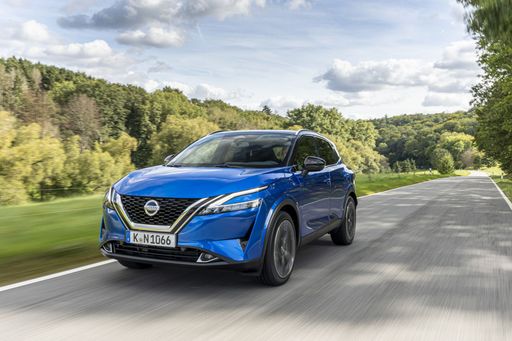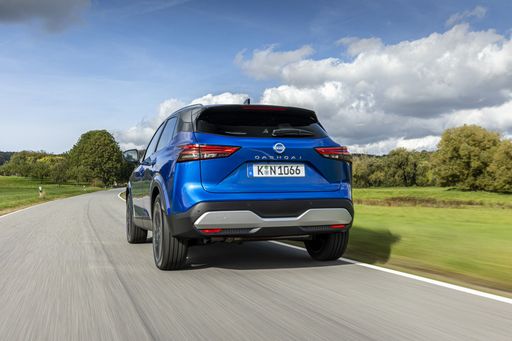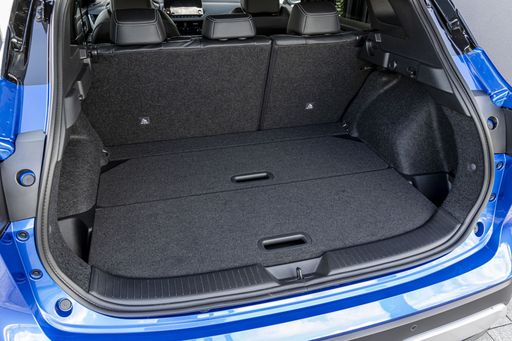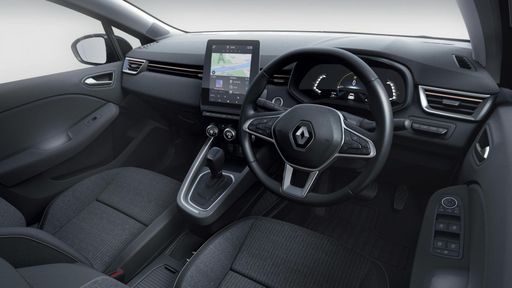Nissan Qashqai vs Renault Clio – Differences & prices compared
Compare performance, boot space, consumption and price in one view.
Find out now: which car is the better choice for you – Nissan Qashqai or Renault Clio?
The Nissan Qashqai (SUV) comes with a Petrol MHEV or Full Hybrid engine and Manuel or Automatic transmission. In comparison, the Renault Clio (Hatchback) features a Full Hybrid or Petrol engine with Automatic or Manuel transmission.
When it comes to boot capacity, the Nissan Qashqai offers 504 L, while the Renault Clio provides 391 L – depending on how much space you need. If you’re looking for more power, decide whether the 190 HP of the Nissan Qashqai or the 143 HP of the Renault Clio suits your needs better.
In terms of consumption, the values are 5.10 L per 100 km for the Nissan Qashqai, and 4.30 L for the Renault Clio.
Price-wise, the Nissan Qashqai starts at 29400 £, while the Renault Clio is available from 16600 £. Compare all the details and find out which model fits your lifestyle best!
When comparing the Nissan Qashqai to the Renault Clio, it's clear that each vehicle caters to different driving needs. The Nissan Qashqai, celebrated for its spacious interior and elevated driving position, appeals to families and those seeking a robust crossover experience. In contrast, the Renault Clio shines in urban settings with its compact size, making it perfect for city dwellers looking for efficiency and style in a small package.
Nissan Qashqai
The Nissan Qashqai stands out in the compact SUV market with its sleek design and versatile features. Its smooth ride and refined interior make it a popular choice for both city driving and weekend adventures. Advanced safety technologies and user-friendly infotainment add to its appeal, ensuring a comfortable and secure driving experience for all passengers.
details @ Nissan
@ Nissan
 @ Nissan
@ Nissan
 @ Nissan
@ Nissan
 @ Nissan
@ Nissan
 @ Nissan
@ Nissan
Renault Clio
The Renault Clio continues to impress with its sleek design and agile handling, making it a standout choice in the compact car segment. Inside, it offers a surprisingly spacious and comfortable cabin, crafted with high-quality materials that enhance the driving experience. Its fuel efficiency and reliable performance make it an attractive option for both city commuting and longer journeys.
details @ renault-presse.de
@ renault-presse.de
 @ renault-presse.de
@ renault-presse.de
 @ renault-presse.de
@ renault-presse.de
A Dynamic Duo: Nissan Qashqai vs. Renault Clio
In the ever-evolving automotive landscape, compact SUVs and hatchbacks are at the forefront. The Nissan Qashqai and Renault Clio stand out in this arena, each delivering a unique blend of performance, efficiency, and style. Whether you're towing a trailer on a family trip or navigating urban streets, these vehicles promise to meet diverse needs with aplomb. Let's compare these two models under the magnifying glass of technical specifications and innovations.
The Stature: Body Type and Design
Nissan's Qashqai embodies the robust, commanding presence typical of an SUV. With dimensions of 4425mm in length, 1835mm in width, and 1625mm in height, it offers consumers a spacious and comfortable ride, with room for five passengers and a sizable trunk capacity of up to 504 liters.
On the other hand, Renault's Clio presents a sleek hatchback profile, perfect for city driving. Standing at 4053mm long, 1798mm wide, and 1440mm high, the Clio is crafted to deftly maneuver through tight urban environments, while comfortably accommodating five passengers with a decent trunk capacity of 391 liters.
Power Play: Engine and Performance
Under the hood, the Qashqai offers a mix of petrol MHEV (Mild Hybrid Electric Vehicle) and full hybrid engines. Drivers can choose from power ranges of 140 to 190 HP, managed through either a manual gearbox, CVT, or reduction gearbox transmission. With a top speed of up to 206 km/h and an acceleration from 0 to 100 km/h in just 7.9 seconds, the Qashqai ensures a thrilling drive.
The Clio offers a diversified power plant as well, featuring engines across full hybrid, petrol, and LPG. With options like the 143 HP full hybrid reaching 0 to 100 km/h in 9.3 seconds and a top speed of 174 km/h, or smaller petrol variants, the Clio is perfectly suited for both efficiency-minded and performance-oriented drivers alike.
Efficiency and Eco-Friendliness
Nissan's commitment to efficiency is evident, with consumption figures ranging between 5.1 and 6.8 liters per 100km. Combined with a CO2 emissions range from 116 to 154 g/km, the Qashqai strikes a balance between performance and environmental responsibility.
Renault Clio continues to impress with a remarkable consumption of 4.3 to 7 liters per 100km, accentuated by a CO2 emissions range between 97 and 130 g/km, making it an environmentally conscious choice.
Conclusion: Which One is For You?
Ultimately, the decision between the Nissan Qashqai and the Renault Clio depends on lifestyle needs. For those craving more cabin space and versatility, the Qashqai delivers SUV quality with technological advancements. Conversely, the Clio encapsulates the agility and efficiency of a hatchback, ideal for urbanites looking for a stylish ride through the cityscape.
Regardless of your choice, both models stand as commendable entries in their respective categories, offering innovative solutions and a satisfying driving experience.

|

|
|
|
|
Costs and Consumption |
|
|---|---|
|
Price
29400 - 42500 £
|
Price
16600 - 23000 £
|
|
Consumption L/100km
5.1 - 6.8 L
|
Consumption L/100km
4.3 - 5.3 L
|
|
Consumption kWh/100km
-
|
Consumption kWh/100km
-
|
|
Electric Range
-
|
Electric Range
-
|
|
Battery Capacity
-
|
Battery Capacity
0.60 kWh
|
|
co2
116 - 154 g/km
|
co2
97 - 121 g/km
|
|
Fuel tank capacity
55 L
|
Fuel tank capacity
39 - 42 L
|
Dimensions and Body |
|
|---|---|
|
Body Type
SUV
|
Body Type
Hatchback
|
|
Seats
5
|
Seats
5
|
|
Doors
5
|
Doors
5
|
|
Curb weight
1420 - 1665 kg
|
Curb weight
1124 - 1331 kg
|
|
Trunk capacity
479 - 504 L
|
Trunk capacity
301 - 391 L
|
|
Length
4425 mm
|
Length
4053 mm
|
|
Width
1835 mm
|
Width
1798 mm
|
|
Height
1625 mm
|
Height
1440 mm
|
|
Payload
466 - 520 kg
|
Payload
398 - 406 kg
|
Engine and Performance |
|
|---|---|
|
Engine Type
Petrol MHEV, Full Hybrid
|
Engine Type
Full Hybrid, Petrol
|
|
Transmission
Manuel, Automatic
|
Transmission
Automatic, Manuel
|
|
Transmission Detail
Manual Gearbox
|
Transmission Detail
Automatic Gearbox, Manual Gearbox
|
|
Drive Type
Front-Wheel Drive, All-Wheel Drive
|
Drive Type
Front-Wheel Drive
|
|
Power HP
140 - 190 HP
|
Power HP
67 - 143 HP
|
|
Acceleration 0-100km/h
7.9 - 10.2 s
|
Acceleration 0-100km/h
9.3 - 17.1 s
|
|
Max Speed
170 - 206 km/h
|
Max Speed
160 - 174 km/h
|
|
Torque
240 - 330 Nm
|
Torque
95 - 205 Nm
|
|
Number of Cylinders
3 - 4
|
Number of Cylinders
3 - 4
|
|
Power kW
103 - 140 kW
|
Power kW
49 - 105 kW
|
|
Engine capacity
1332 - 1497 cm3
|
Engine capacity
999 - 1598 cm3
|
General |
|
|---|---|
|
Model Year
2024
|
Model Year
2023 - 2025
|
|
CO2 Efficiency Class
E, D
|
CO2 Efficiency Class
C, D
|
|
Brand
Nissan
|
Brand
Renault
|
Nissan Qashqai
Exploring the New Nissan Qashqai: A Masterclass in Innovation and Performance
The Nissan Qashqai stands as a testament to the brand's continuous evolution in the competitive SUV market. Building on its robust reputation, the latest models bring a blend of style, efficiency, and groundbreaking technology that cater to the modern driver's needs. As we delve into the technical nuances and innovative features, it becomes evident why the Qashqai remains a top contender in its segment.
Powertrain and Efficiency: A Harmonious Balance
The latest Nissan Qashqai models feature an advanced range of powertrain options, including both mild-hybrid and full-hybrid systems. The 1.3 DIG-T MHEV engines provide power outputs ranging from 140 to 158 PS, ensuring a responsive driving experience while maintaining a remarkable fuel efficiency of 6.3 L/100km for automatic front-wheel drive versions. The full-hybrid 1.5 VC-T e-POWER delivers an impressive 190 PS while achieving a fuel efficiency of just 5.1 L/100km, demonstrating Nissan's commitment to ecological innovation.
Advanced Transmission Systems
Drivers can choose between manual or automatic transmissions, tailored to their driving style. The manual gearbox offers a tactile driving experience, while the automatic options, including a CVT and reduction gear transmission, ensure seamless power delivery and heightened efficiency. For those who seek greater traction and stability, all-wheel drive configurations are also available, enhancing the Qashqai's versatility.
High-Tech Interior: Comfort Meets Connectivity
The Qashqai's interior is a sanctuary of technology and comfort. The SUV features a user-friendly infotainment system with a touchscreen interface, compatible with both Android Auto and Apple CarPlay. The seamless integration of technology extends to advanced driver-assistance systems (ADAS) that include ProPILOT with Navi-link, enhancing convenience and safety during long drives or urban manoeuvres.
Performance and Dynamics: The Driving Experience
When it comes to performance, the Qashqai does not compromise. With acceleration from 0-100 km/h in as little as 7.9 seconds in the more powerful hybrid editions, and a top speed ranging from 170 to 206 km/h, Nissan ensures that excitement is part and parcel of the Qashqai driving experience. This balance of power and control is complemented by a well-tuned suspension system and precise steering response, providing a confident drive whether on highways or country lanes.
Design and Practicality: Where Form Meets Function
Sporting an aerodynamic silhouette, the Qashqai exudes a modern vibe that is both eye-catching and functional. Its dimensions, with a length of 4425 mm and a width of 1835 mm, provide ample cabin space for five passengers, along with a versatile boot capacity of up to 504 litres. These aspects make it an ideal choice for families and adventurers alike.
Conclusion: A Forward-Thinking Choice
The Nissan Qashqai remains a steadfast choice for those seeking an SUV that blends innovative technology with everyday practicality. With its advanced hybrid options and cutting-edge features, it not only meets but often exceeds the demands of today's environmentally conscious and tech-savvy drivers. As Nissan continues to push boundaries, the Qashqai stands as a beacon of what modern SUVs can achieve.
Renault Clio
Introduction to the Renault Clio
The Renault Clio, a popular choice among compact cars, has continually advanced its design and technology to maintain a strong position in the automotive market. With enhancements in engineering, efficiency, and aesthetic appeal, the Clio remains a top contender in the hatchback category.
Advanced Hybrid Technology
The Renault Clio's hybrid technology is one of its standout features. The E-Tech Hybrid system optimises both performance and efficiency, offering a seamless transition between electric and fuel-powered driving. This setup results in an impressive fuel consumption rate of 4.3 L/100km, making it an attractive option for eco-conscious drivers.
Efficient Engine Options
Renault offers a variety of engine choices for the Clio, accommodating different driving styles and preferences. From the economical SCe 65 manual variant to the powerful TCe 100 LPG gas version, each option is engineered to balance performance with fuel efficiency. With outputs ranging from 67 to 143 PS, drivers can enjoy a tailored driving experience.
Design and Comfort
The Renault Clio stands out with its sleek and modern design, characterized by its hatchback body style. The interior boasts an ergonomic layout with seating for five, ensuring passenger comfort and convenience. With a boot capacity of 301 to 391 litres, the Clio also offers practical storage solutions for everyday use.
Safety and Innovation
Safety is a key priority for Renault, and the Clio reflects this commitment with its suite of innovative safety features. Advanced driver-assistance systems are integrated throughout, enhancing both safety and usability. The Clio encompasses features like lane departure warning, automatic emergency braking, and adaptive cruise control.
Cost Efficiency and Environmental Impact
The Renault Clio not only offers affordability with pricing ranging from €18,450 to €26,800, but also promises low running costs. With CO2 emissions between 97 and 130 g/km, the Clio fits well within the C and D efficiency classes. This makes it a cost-effective and environmentally friendly choice for modern drivers.
Conclusion
Renault Clio remains a dynamic, dependable and economical option in the compact car segment. With its innovative technologies, diverse engine options, and commitment to safety and design, the Clio continues to impress and adapt to the evolving demands of the automotive world.
What drive types are available for the Nissan Qashqai?
The Nissan Qashqai is offered with Front-Wheel Drive or All-Wheel Drive.
The prices and data displayed are estimates based on German list prices and may vary by country. This information is not legally binding.
